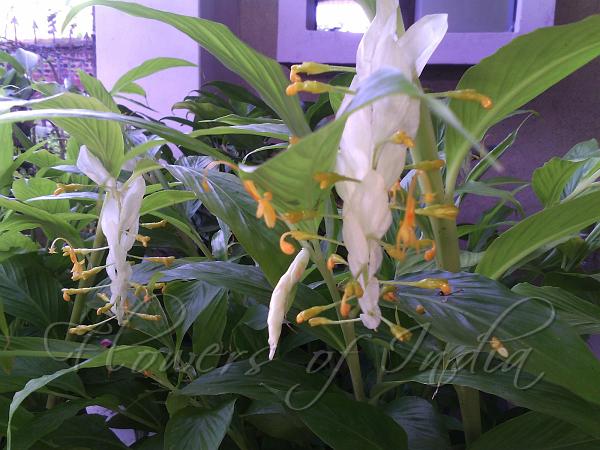|
| East-Indian Swan Flower |
|

|

|
|
|
|
Photo: |
Botanical name: Globba sherwoodiana Family: Zingiberaceae (Ginger family)
East-Indian Swan Flower is a perennial herbs with leafy
shoots slender, 30-40 cm tall, light green in colour. It is named in
honor of Dr. Shirley Sherwood, a great lover of plants and a patron of
contemporary botanical art. Flowers are borne at branch-ends, in
drooping clusters, 8-12 cm long, flower-cluster-stalk 3-4 x 0.4-0.5 cm,
pale green. Snow-white bracts are spirally arranged, reflexed,
overlapping and widely separated, ovate to ovate-oblong, decreasing in
size from base to the tip, 2.5-3 x 1.5- 1.8 cm. Bracteole are tubular,
smaller than the bract, persistent. Flowers are small, stalkless,
yellowish-orange, 4-4.5 cm long. Flower tube is 1.1-1.4 cm long,
slender, widening gradually towards the mouth, with petals reflexed.
Petals are 3; dorsal petaal concave, about 0.5 x 0.2 cm, orange in
color; lateral petal ovate, about 0.5 x 0.2 cm. Lip is triangular,
0.6-0.8 x 0.2-0.4 cm, orange-yellow with a reddish patch at center, tip
deeply bifid, hairless. Lateral staminodes are elliptic, 0.7-1 x
0.2-0.5 cm, orange-yellow, hairless. Filament slender, about 1.6-2.6 cm
long, orange, hairless, anther linear, 0.2-0.3 cm long, thecae
parallel, with two triangular appendages on either side, hairless.
Style thread-like, stigma with hairy margin. Sepal-cup is tubular,
0.3-0.4 cm long, trilobed, greenish -yellow, hairless.
Leaves are 6-8 in number, shortly stalked, oblong-lanceshaped, 15-20 x
5-8 cm, margin entire, lower surface minutely velvet-hairy along the
mid rib, upper surface hairless, tip tapering, base narrowed. East-Indian
Swan Flower is found in NE India to Myanmar. Flowering:
August-September.
| Identification credit: Tabish | Photographed in Imphal, Manipur. |
• Is this flower misidentified? If yes,